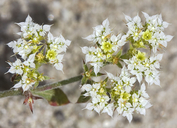notes Inflorescences of Chorizanthe diffusa, the stem here was being held up off the ground for the photo (the stems typically grow prostrate). The plants were growing in poor sandstone-derived soils along the summit ridge of Indian Knob. As in most Chorizanthe species, it's easy for a novice to misconstrue the involucres for the 'flowers' (i.e. perianths). The pretty, white, 3-lobed items...with the lobes mostly oval but with tips tapering to a long point...are referred to as the 'scarious-margined involucre teeth'. ('Scarious' here means membranous, and there are actually six teeth at the tip of the involucre: 3 long ones alternating with 3 much shorter ones.) Those white scarious margins are more conspicuous than the actual perianths, and massed together are more prominent as a visual 'advertisement' to attract pollinating insects.
Out of the center of each involucre, a single 6-lobed perianth will emerge...within which reside the stamens and pistil. Nectar is produced at the interior base of the perianth, and that's what attracts pollinators (as in this image). The perianths are smaller and short-lived, while the white scarious membranes joining the involcre teeth are persistent. Often the inflorescences will appear conspicuous due to the involucral membranes...even though there may be no perianths in flower at the time. In this photo there are only 5 open perianths in flower...they are bell-shaped; 6 lobed, with the lobes rounded and of equal size; and with their centers yellowish-green. The are a number of involucres with the tips of their perianth buds peaking out...soon to flower in the coming day(s).
It seems to me the population of C. diffusa here on Indian Knob has perianths with decidedly more yellow beyond the greenish-throat than those of the more northerly populations I've seen...which are more white beyond the greenish throat. Compare with this image from the Santa Cruz sandhills, and this image from Ft. Ord. Perhaps that's just variable throughout both northern and southern populations of the species, but I'll keep an eye out in the future to see if there's a consistent difference.
